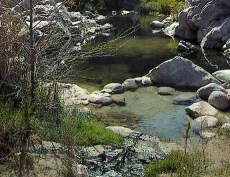Article Published: Monday, July 07, 2003 - 7:48:11 PM PST
Forces of the forest
3 crews from college part of 'safety net' in mountains
By C.J. SCHEXNAYDER, Staff Writer
Kris Mclean is gearing up for months of sweat, dirt, hard work and, eventually, walls of fire.
The 26-year-old Apple Valley resident is one of about five dozen firefighters, many of them students, known as the "Mojave Greens.' They are based at Victor Valley Community College and serve as part of the fire "safety net' for the San Bernardino Mountains.
"I just love doing this,' Mclean said. "I love being out here and doing something important. When you are part of putting out a fire and helping people it makes all the work worth it.'
The Mojave Greens back up fire crews battling blazes in the San Bernardino National Forest. When the primary forest "hotshot' crews are sent to fight fire elsewhere, the three Mojave Greens crews totaling up to 70 firefighters take up the slack and guard the forest.
They have never been more needed. Four years of drought and an infestation of bark beetles have killed more than a million trees in the San Bernardino Mountains. That, along with the fact that the forest is one of the most densely populated in the country, has prompted fire officials to recognize the area as having the greatest fire threat in the nation.
Having highly trained reserves on hand and ready to go is critical in such a situation, said Battalion Chief Betty Ash, who oversees the program for the Forest Service.
The crews have spent most of the past few weeks clearing the dead trees out of a 3.5-mile stretch of rural road that will allow firefighters to light a backfire to protect the community of Sugar Loaf if a major fire occurs.
Hard labor a given
The work is a whirlwind of wood chips as two crews move from either end of the road toward each other. The crews clear limbs and brush, leaving the felled trees for residents to take as firewood.
"I expected to be doing some hard work,' said Wil Draper, 22, of Big Bear Lake. "We all are here to get down and dirty.'
According to Dave Mathews, chairman of the Fire Technology Department at Victor Valley College, the program is a unique way for students looking for hands-on experience to get employment with the Forest Service.
And its popularity is growing.
For years, the college offered an annual class of about 25 students. Now it offers two classes of 50 students.
Each year, Ash said, the Forest Service receives hundreds of applications for the 80 or so slots.
Those that make it have a special mix of skill, training and that certain undefinable desire to do the work, Ash said.
"It's something that is in the blood,' Ash said. "It's what you just feel you need to do even if you can't quite explain it.'
The program began in 1978 when the late Charles Peterson, a professor at the school, decided his fire-training students could use some hands-on experience.
"He got a bunch of students together and threw some tools in the back of pickups and found the Forest Service folks fighting some fires, then offered to help,' Ash said.
The students helped battle blazes in the Big Bear Lake area and Coyote Flat, acquainting themselves well with Forest Service officials who worked with them. The next year the agency provided funding and instruction for the program, making it an integral part of the firefighting efforts in the national forest.
Getting ready to go
Today the program has been refined to provide an almost seamless transition from the college to the field.
Students start with taking the school's firefighting courses at the college, Mathews said.
"They begin with our basic wildland fire academy, which is a 44-hour course that introduces students to the skills they will need to apply for a job with the U.S. Forest Service,' he said.
After completing the course, the students then take the Forest Service's medical and physical agility tests as well as about 80 hours of the agency's mandated training classes.
"We treat them just like Forest Service employees,' Ash said.
The difference is that they are seasonal employees, don't have the same benefits and their pay is on a different scale. Many of the standouts will be recruited for the regular hotshot crews during the season, said crew representative Rocco Terracciano.
But not all of the Mojave Greens who serve each summer are students. Many are veterans of the program who return year after year. While they don't take the college course work, they are required to retake the Forest Service training every year, Ash said.
The veterans, including Mclean, who is in his sixth year in the program, are key to keeping the training at a high level, said Crew Boss Sal Reyes.
"We depend a lot on these more experienced guys that have been around,' he said. "They help us bring along these guys out here for their first season.'
Mclean worked with first-year Mojave Green Rocky Rhodes cutting trees for the clearing effort. Rhodes said the experience has already been remarkable.
"You learn a lot in the classroom, but it's not the same as when you get out here to see it and do it yourself,' Rhodes said .
You Are Not Alone - The Mojave Greens are Watching
All posts are those of the individual authors and the owner
of this site does not endorse them. Content should be considered opinion
and not fact until verified independently.
| Subject | Author | Views | Posted |
|---|---|---|---|
| katrina island | 3454 | July 10, 2003 11:39AM |
Sorry, only registered users may post in this forum.



